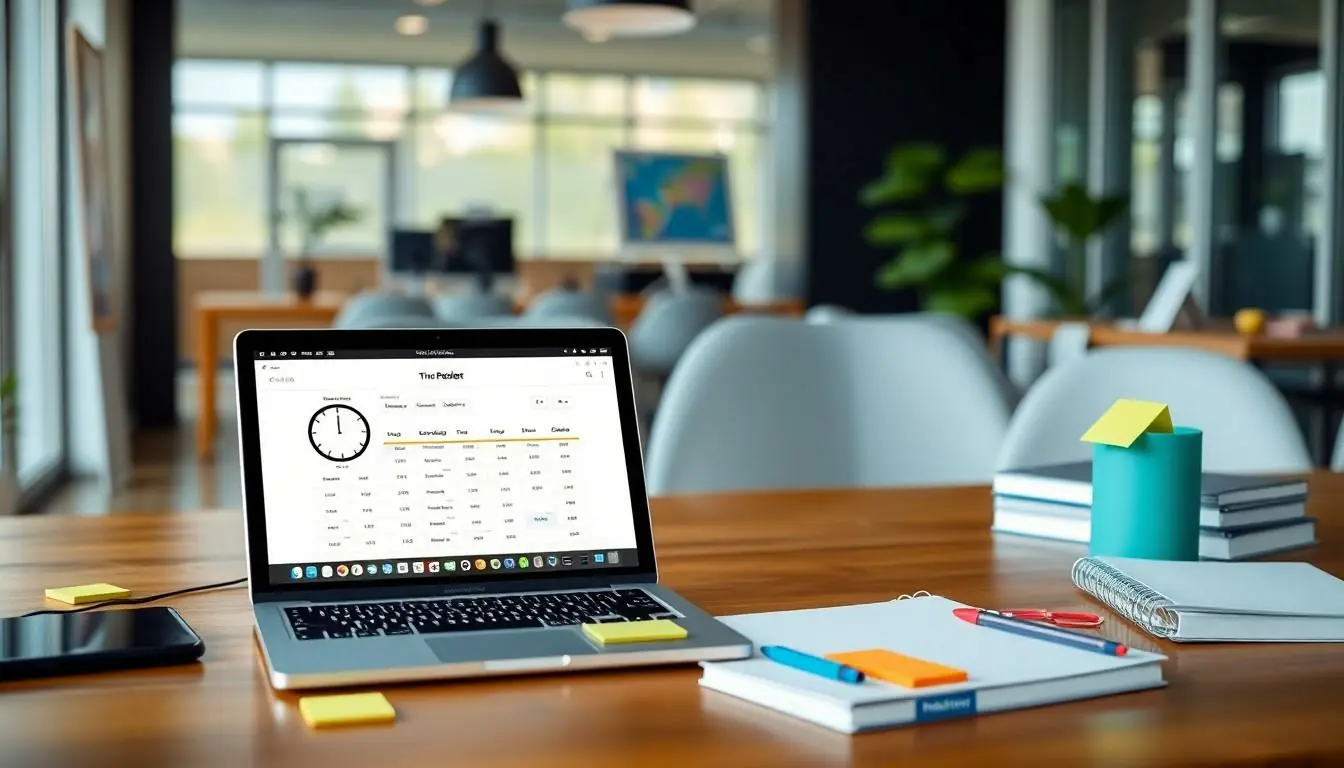Table of Contents
ToggleIn a world where distractions are just a notification away, mastering time management feels like trying to herd cats. With deadlines looming and to-do lists growing, it’s no wonder many find themselves wishing for a magic wand—or at least a reliable app. Luckily, technology has come to the rescue, offering a smorgasbord of time management tools designed to help anyone regain control of their day.
From organizing tasks to tracking productivity, these apps promise to turn chaos into clarity. They’re like having a personal assistant who doesn’t need coffee breaks or a salary. So whether you’re a busy professional, a student juggling classes, or just someone trying to find time for Netflix, these apps can help you reclaim those precious hours. Get ready to boost your productivity and maybe even find a little extra time for yourself—because who doesn’t want that?
Overview of Time Management Apps
Time management apps serve a vital role in enhancing individual productivity. These tools help in organizing tasks, setting reminders, and tracking progress. Professionals and students alike leverage these applications for better control over their workloads.
Many options exist in the market, each designed with unique features. Popular apps like Todoist offer task prioritization and collaboration capabilities, making them ideal for team projects. Similarly, Trello uses a visual board format that simplifies task management and project tracking.
Focus booster apps, such as Pomodoro Technique-based tools, assist users in breaking work into intervals. These apps encourage users to maintain concentration while providing scheduled breaks. Trackers like RescueTime automatically record time spent on applications and websites, offering insights into productivity patterns.
Goal-setting apps serve a different purpose, encouraging users to set and achieve specific objectives. They provide useful frameworks for personal growth and help maintain motivation. Tools like Notion combine note-taking with task management, providing flexibility in how users organize their information.
Accessibility across devices represents another key aspect. Most apps synchronize data in real-time, allowing users to access their schedules from smartphones, tablets, or desktops. Collaboration features enable teams to coordinate better and share updates instantaneously.
In sum, time management apps facilitate a more structured approach to productivity. They cater to varying preferences and workflows, ultimately aiding users in achieving their goals. Utilizing these applications improves time management, allowing individuals to concentrate on what truly matters.
Features to Look For

Choosing the right time management app involves identifying key features that enhance productivity. Understanding these features allows users to make informed decisions.
User Interface and Experience
An intuitive interface significantly impacts how users interact with the app. Easy navigation and clear layouts reduce frustration and streamline task management. A visually appealing design keeps users engaged and motivated. Users benefit from features like drag-and-drop functionality, which simplifies task organization. Responsive design ensures accessibility across devices, allowing seamless use whether on a smartphone or computer.
Customization Options
Flexibility in customization caters to individual workflows. Users should look for apps that allow personalization of task lists, reminders, and layouts. Setting unique priorities or color-coding tasks enhances visual organization. Customizable notifications keep users focused, alerting them when deadlines approach or tasks are due. The ability to create templates for recurring tasks boosts efficiency and saves time.
Integration with Other Tools
Integration capabilities enhance the utility of time management apps. Syncing with calendars, communication platforms, or project management tools improves productivity. Connection to tools like Google Calendar or Slack streamlines scheduling and collaboration. Users benefit from data integration, providing insights across different applications. Effective integration reduces task duplication and ensures all information remains up-to-date.
Best Apps for Time Management
Several apps available today cater to time management needs, helping users maximize productivity and streamline their schedules. Below are some of the best options, offering unique features tailored for various preferences.
App 1: Todoist – Description and Key Features
Todoist stands out with its task prioritization capabilities. Users can organize tasks into projects and assign deadlines. Collaboration features allow teams to work together seamlessly on shared projects. It offers a clean interface that enhances visibility and ease of use. Notifications remind users of upcoming deadlines. Furthermore, integrations with calendars and productivity tools provide a centralized workflow.
App 2: Trello – Description and Key Features
Trello excels in visual project management. The app utilizes boards, lists, and cards to represent tasks and progress. Users can assign tasks to team members, making delegation simple. Customizable cards include checklists, due dates, and attachments for thorough task management. Real-time updates keep everyone in sync, which enhances team collaboration. Due to its flexibility, Trello adapts to various workflows and project types.
App 3: RescueTime – Description and Key Features
RescueTime provides deep insights into productivity patterns. The app automatically tracks the time spent on applications and websites. Users receive detailed reports showing productivity trends over time. Customizable goals help users stay focused on their objectives. Daily alerts remind users to stay on track with their time management. This data-driven approach empowers individuals to make informed decisions about their work habits.
Comparing Free vs. Paid Apps
Free time management apps offer essential features that suffice for basic task organization and scheduling tasks. These apps, such as Todoist’s basic version, enable users to create lists, set reminders, and organize priorities without any financial investment. Many free options also provide limited collaboration tools, inviting users to share tasks or projects with others.
Paid apps, however, deliver advanced functionalities that enhance productivity. Investing in a premium plan often unlocks features like automation, advanced reporting, and integrations with other tools. Trello’s paid tiers, for instance, allow teams to access unlimited boards and enhance the visual workflow with custom backgrounds and stickers.
Not all users require the comprehensive features that paid versions offer. Some individuals find that the free versions meet their needs, while others appreciate the time-saving potential of premium features. Task automation in paid apps, for example, can significantly reduce repetitive work and streamline project management.
User experience varies across both free and paid apps. Free apps frequently come with ads or limited access to customer support, which might frustrate some users. In contrast, paid options typically provide dedicated support, ensuring assistance when users encounter challenges.
The decision to choose between free and paid apps hinges on the individual’s specific needs and workflows. Users focused on intricate project tracking and collaboration may find value in paid subscriptions. For those who manage simpler tasks and prefer budget-friendly options, free apps offer enough functionality to enhance productivity.
Choosing the right time management app can significantly impact productivity and overall well-being. With a variety of options available users can find tools that align with their specific needs and preferences. Whether it’s task prioritization through Todoist or visual project management with Trello each app offers unique features that cater to different workflows.
Investing time in exploring these apps not only helps in managing tasks effectively but also fosters a healthier work-life balance. Embracing technology in this way empowers individuals to take control of their time and focus on what truly matters in their personal and professional lives.




